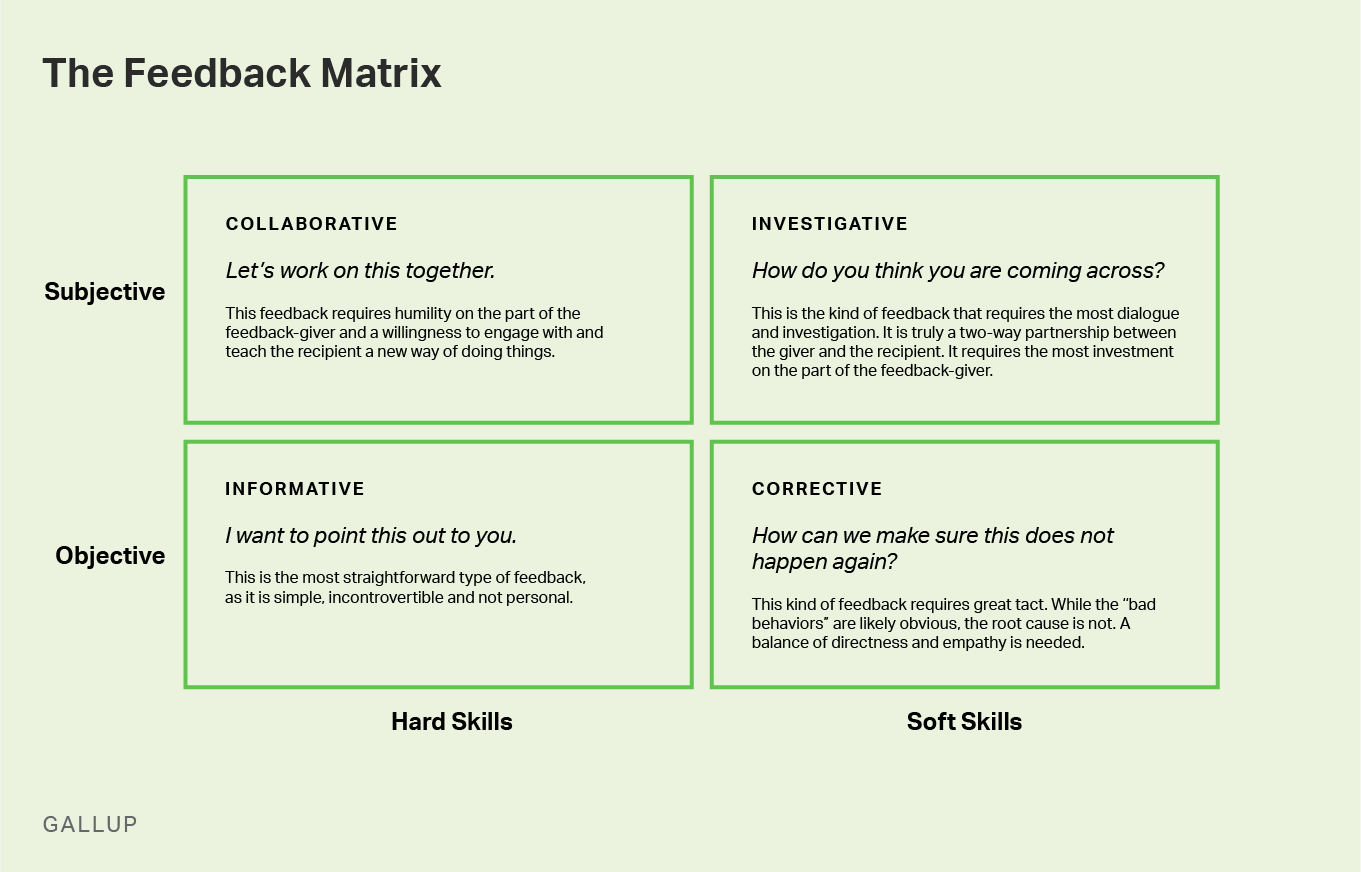Story Highlights
- Different workplace scenarios require different kinds of feedback
- Collaborative and informative feedback focus on hard skills
- Investigative and corrective feedback focus on interpersonal skills
How should you tell your employee that his presentation to the client was boring? Point it out directly? "Sandwich" it with positive feedback about his other work? Wait until he actually makes a good presentation, and then focus him on the positives? Hope the client's reaction was feedback enough?
Those are all valid choices -- but they're not effective approaches for development.
Much has been written about how to give good feedback. Some near-universal principles have emerged, but specific recommendations vary widely -- and we seldom pause to define what kind of feedback to give based on the situation at hand.
Does the situation call for a critique of "hard" skills (i.e., the quality of the tangible output) or soft skills (i.e., the quality of the human interaction)? Where is the real problem? Where is the real opportunity?
This may be why only 26% of employees strongly agree that the feedback they get helps them do better work, according to Gallup research.
If feedback-givers appropriately categorize what they are communicating, the feedback will miss the mark less often, they will avoid insulting people, and it will accelerate employee development.
Giving the right kind of feedback improves performance, development -- and it may help engagement, too. Given how high the stakes are, how exactly can you give the right kind of feedback?
First, feedback on hard skills should be vastly different than feedback on interpersonal skills. Next, each of these two general categories can be subdivided into objective and subjective failures. Before giving feedback, run through this simple matrix:
Hard skills:
- Objective: an email contains typos or grammatical errors
- Subjective: the content of an email was unclear (in the eyes of the manager)
Soft skills:
- Objective: a manager blew up at an employee
- Subjective: a manager comes across as cold and uncaring

Collaborative: Let's work on this together.
This feedback requires humility on the part of the feedback-giver and a willingness to engage with and teach the recipient a new way of doing things.
Examples:
- an email was unclear
- an analysis was too shallow
How to approach it:
- Seek external perspectives: Given that no one is infallible, the feedback-giver should, when possible, seek the input of others before sharing feedback.
- Make it a busy, two-way highway: The feedback-giver should share their perspective on the issue and ask how it strikes the recipient. The aim here is for the feedback-giver to persuade and teach the recipient.
- Be didactic (teach and coach toward the ideal): The feedback-giver should show the recipient "what great looks like" and then coach the recipient through iterative attempts to achieve this ideal state.
Investigative: How do you think you are coming across?
This is the kind of feedback that requires the most dialogue and investigation. It is truly a two-way partnership between the giver and the recipient. It requires the most investment on the part of the feedback-giver.
Examples:
- a presentation was boring
- a manager comes across as cold and uncaring
How to approach it:
- Seek external perspectives: Given that no one is infallible, the feedback-giver should, when possible, seek the input of others before sharing feedback.
- Make it a busy, two-way highway: The feedback-giver ought to be willing to work with the recipient over time to help improve their skills.
- Be Socratic (ask questions to find a collaborative solution): "How did you feel about the presentation? Did the audience seem engaged? Why do you think that is? How might we improve together?"
Informative: I want to point this out to you.
This is the most straightforward type of feedback, as it is simple, incontrovertible and not personal.
Examples:
- an email contains typos
- an analysis was conducted with the wrong methodology
How to approach it:
- Be direct (and constructive): "I just noticed there were a few typos in your email. Can you please double-check for those in the future?"
- Be solution-oriented: If errors are recurring, the feedback-giver should point the recipient toward helpful resources.
- Be available and supportive: The feedback-givers should make themselves available to help the recipient move toward a solution.
Corrective: How can we make sure this does not happen again?
This kind of feedback requires great tact. While the "bad behaviors" are likely obvious, the root cause is not. A balance of directness and empathy is needed.
Examples:
- a manager blew up at an employee
- an employee is dismissing their work
How to approach it:
- Be direct (and constructive): "Losing your temper with Jim was unacceptable, and we need to make sure it never happens again."
- Be solution-oriented: "Let's discuss a plan to prevent this from happening again."
- Be empathetic: "What was going on at the time? Why did you act this way?"
When we fail to distinguish between these categories, our feedback often misses the mark. We give excellent hard skills feedback for an interpersonal issue and then feel frustrated that change does not occur. Or we give feedback that would be appropriate for an objective failure about something subjective and offend our employee.
If feedback-givers appropriately categorize what they are communicating, the feedback will miss the mark less often, they will avoid insulting people, and it will accelerate employee development.
Your employees may even start looking forward to receiving feedback after client presentations. And you'll start looking forward to those presentations a lot more, too.
Create a workplace culture that encourages the right kind of feedback and includes ongoing coaching conversations:
- Contact Gallup to learn what kind of culture makes employees want to perform better.
- Download Gallup's approach to culture and see how your new view of feedback can help fulfill your organization's purpose.
- Read It's the Manager to learn how to go from boss to coach and have more frequent coaching conversations.




